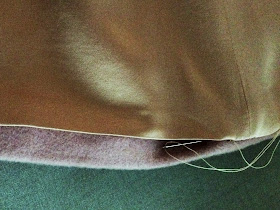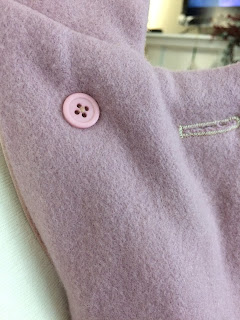This is my first time trying a pattern designed by Katherine Tilton. I was attracted to the unique double collar embellished with zippers.
 |
| I used Riri zipper with copper teeth, size M6. |
I thought my Riri zipper* with its copper teeth was the perfect pairing with the blush toned crepe viscose jersey I purchased from Gorgeous Fabrics. However I only had one yard and that was not enough so I used some leftover rayon jersey as contrast for the collar.
*A note about Riri zipper. I used size M6 which is equivalent to 6mm. I compared that with the M4 and thought the latter was too small. However the M6 added some weight to the collar.
This jersey was leftover from a previous project, Butterick 6241.
The warm mauve jersey was more lightweight than the main fabric so I interfaced with some fusible knit interfacing.
I also used the same interfacing to stabilize the shoulder seams.
The top itself was very easy to sew. The sleeves were sewn flat which is how I usually do it with knits. I decided to shorten the sleeves and forego the cuffs.
However the collar part requires some careful sewing.
Make sure the free end of the zipper tape is sewn well inside the seam.
Otherwise this is what will happen! See that raw edge sticking out to the right side?
After I corrected my mistake, this is what it looked like.
After topstitching.
After assembly.
The overlapping collars resulted in very thick seams.
And I'm happy to say my Juki MO 654 DE serger sewed over the seams with no problem at all!
So I'm very happy with the collar!
However I can't say the same for the rest of the top. I found the fit quite odd.
Although the fit looked like how it did in the pattern envelope, I found it weird in real life.
The shoulders felt too wide and the sleeves were really really tight!
The overall fit was not that of a fitted pullover, more of a tunic style that was shapeless. I would have been happier if the bottom hem was drafted with some shape of sorts like a hi-lo style. As it is, it feels like the style could not decide if it wants to be a plain t-shirt or a tunic. I guess I have been spoiled by Jalie patterns. I should have expected this since the sizing was given in ranges (for ex. Size XS was 4-6, S 8-10, etc)
With that said, I still wore the top the last weekend and I'll continue to wear it until I decide to deconstruct it and find a more suitable style.





























































